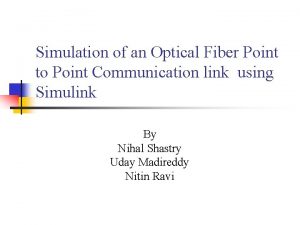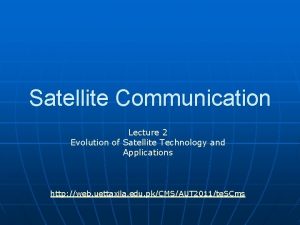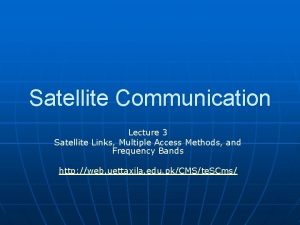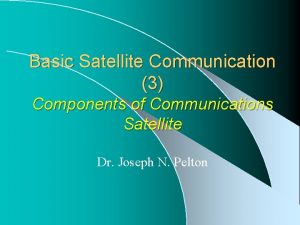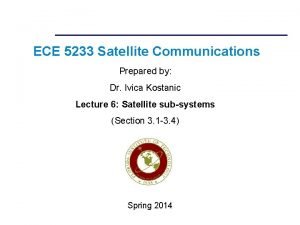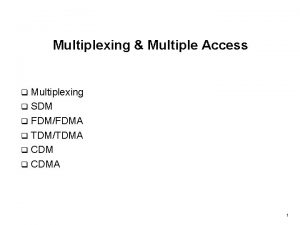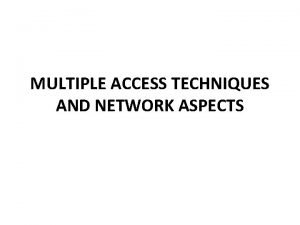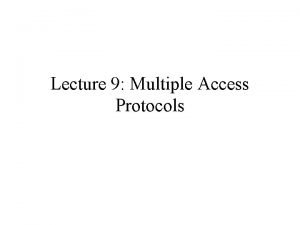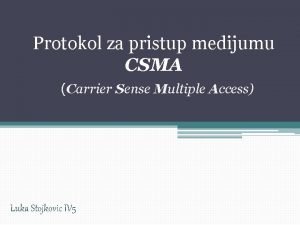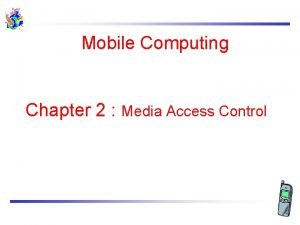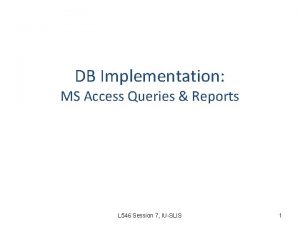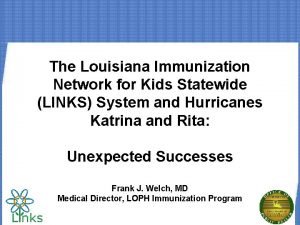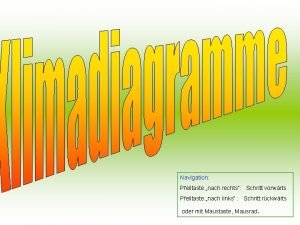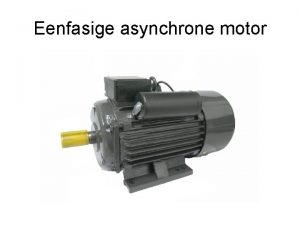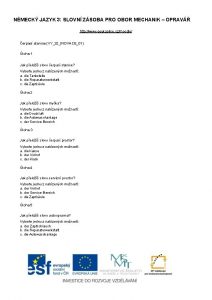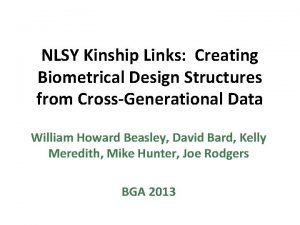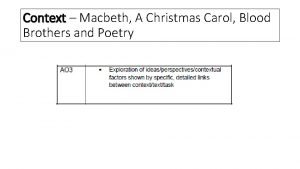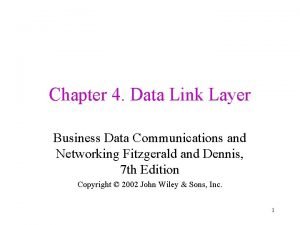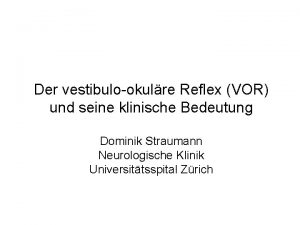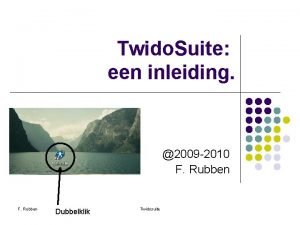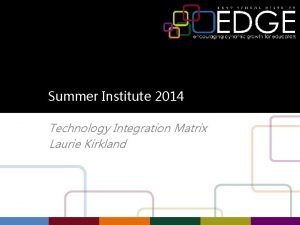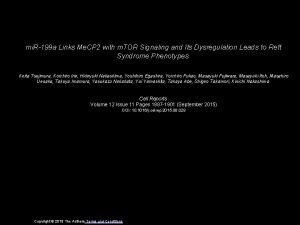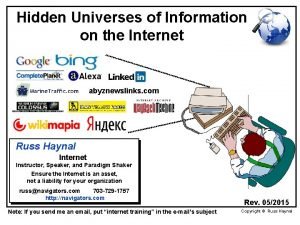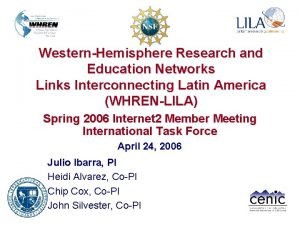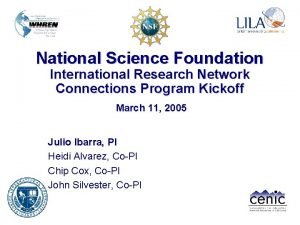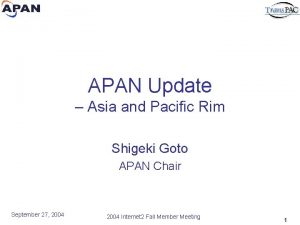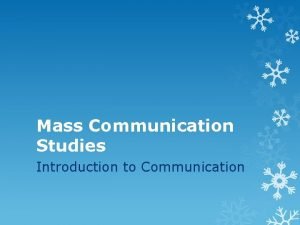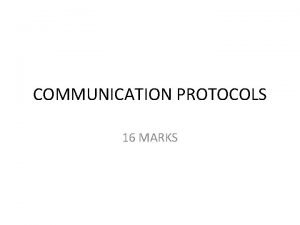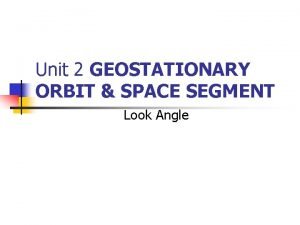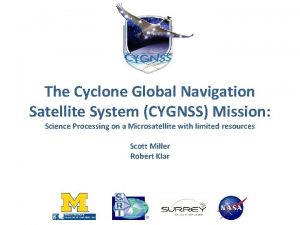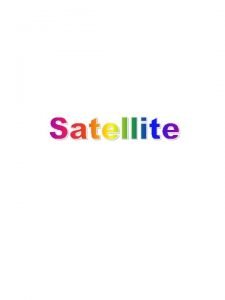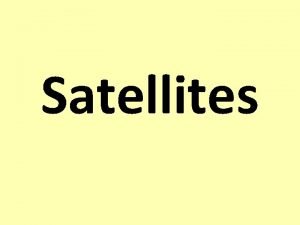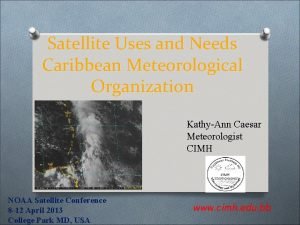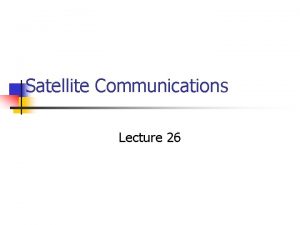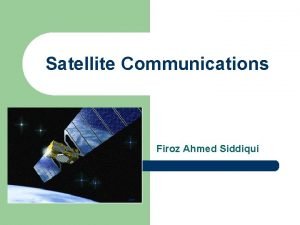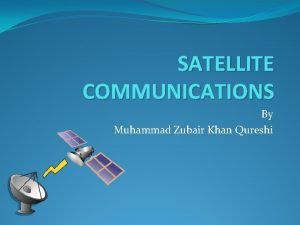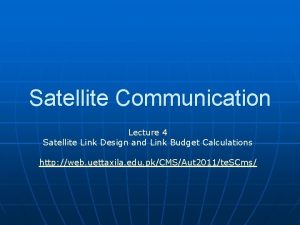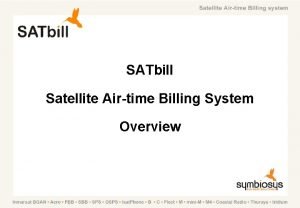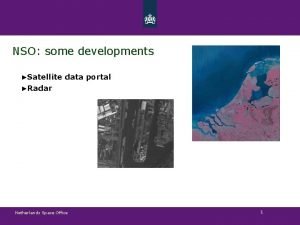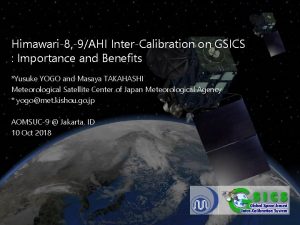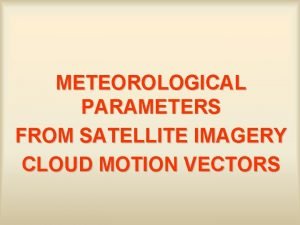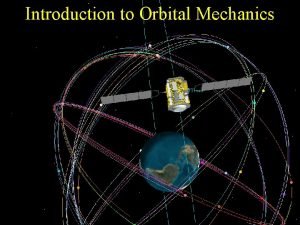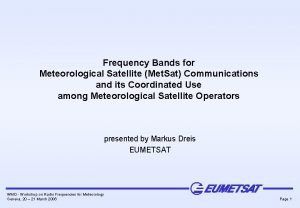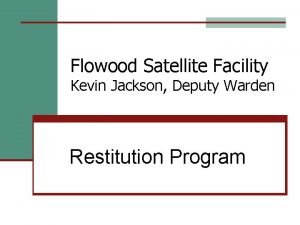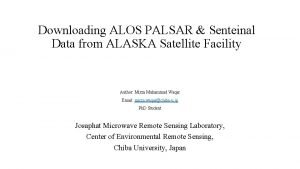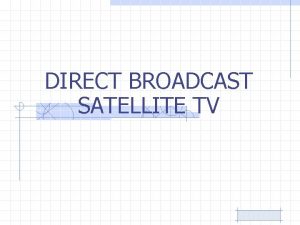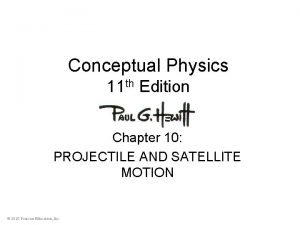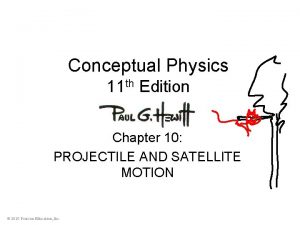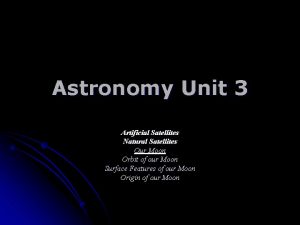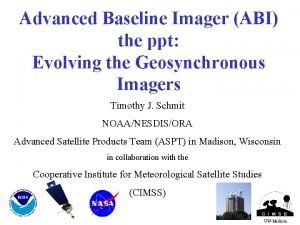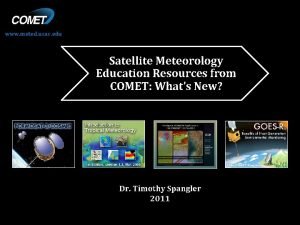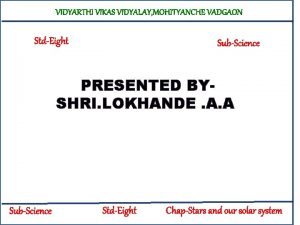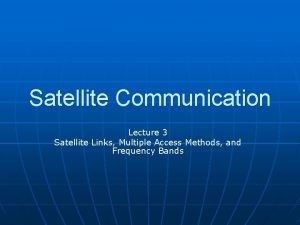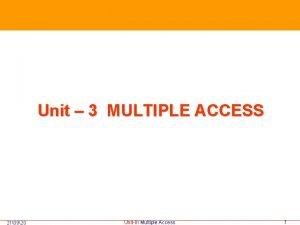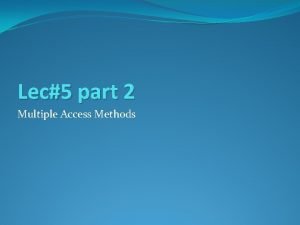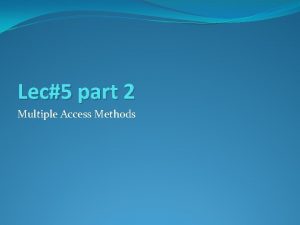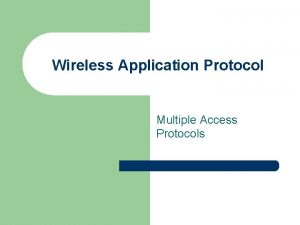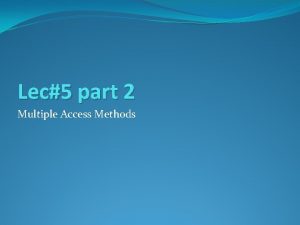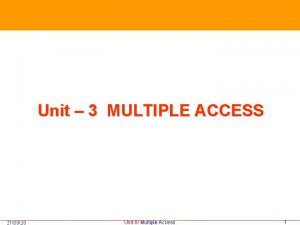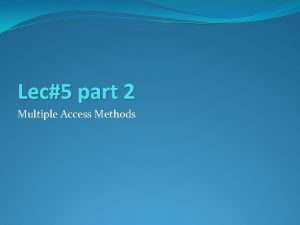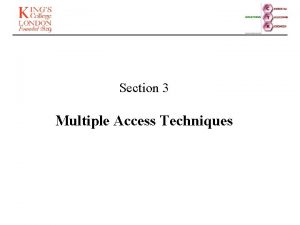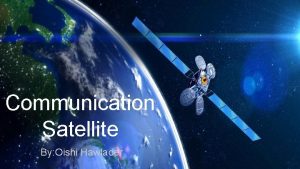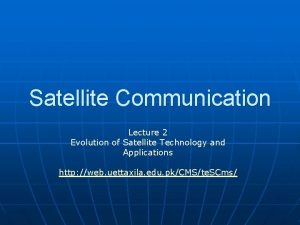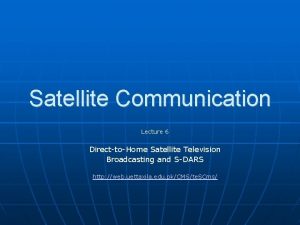Satellite Communication Lecture 3 Satellite Links Multiple Access




































































































- Slides: 100

Satellite Communication Lecture 3 Satellite Links, Multiple Access Methods, and Frequency Bands http: //web. uettaxila. edu. pk/CMS/te. SCms/

Overview n n Design of the Satellite Links Link Budget and their Interpretation Multiple Access Systems Frequency Band Trade-Offs

Design of the Satellite Link n n n The satellite link is probably the most basic in microwave communications since a line-of-sight path typically exists between the Earth and space. This means that an imaginary line extending between the transmitting or receiving Earth station and the satellite antenna passes only through the atmosphere and not ground obstacles. Such a link is governed by free-space propagation with only limited variation with respect to time due to various constituents of the atmosphere.

Design of the Satellite Link n n Free-space attenuation is determined by the inverse square law, which states that the power received is inversely proportional to the square of the distance. The same law applies to the amount of light that reaches our eyes from a distant point source such as an automobile headlight or star. There are, however, a number of additional effects that produce a significant amount of degradation and time variation. These include rain, terrain effects such as absorption by trees and walls, and some lessobvious impairment produced by unstable conditions of the air and ionosphere.

Design of the Satellite Link n n It is the job of the communication engineer to identify all of the significant contributions to performance and make sure that they are properly taken into account. The required factors include the performance of the satellite itself, the configuration and performance of the uplink and downlink Earth stations, and the impact of the propagation medium in the frequency band of interest.

Design of the Satellite Link n n Also important is the efficient transfer of user information across the relevant interfaces at the Earth stations, involving such issues as the precise nature of this information, data protocol, timing, and the telecommunications interface standards that apply to the service. A proper engineering methodology guarantees that the application will go into operation as planned, meeting its objectives for quality and reliability.

Design of the Satellite Link n n The RF carrier in any microwave communications link begins at the transmitting electronics and propagates from the transmitting antenna through the medium of free space and absorptive atmosphere to the receiving antenna, where it is recovered by the receiving electronics. The carrier is modulated by a baseband signal that transfers information for the particular application. The first step in designing the microwave link is to identify the overall requirements and the critical components that determine performance. For this purpose, we use the basic arrangement of the link shown in Figure.

Design of the Satellite Link n Figure 2. 1: Critical Elements of the Satellite Link

Design of the Satellite Link n n The example shows a large hub type Earth station in the uplink and a small VSAT in the downlink; the satellite is represented by a simple frequency translating type repeater (e. g. , a bent pipe). Most geostationary satellites employ bent-pipe repeaters since these allow the widest range of services and communication techniques.

Design of the Satellite Link n n Bidirectional (duplex) communication occurs with a separate transmission from each Earth station. Due to the analog nature of the radio frequency link, each element contributes a gain or loss to the link and may add noise and interference as well.

Design of the Satellite Link n n n The result in the overall performance is presented in terms of the ratio of carrier power to noise (the carrier-to-noise ratio, C/N) and, ultimately, information quality (bit error rate, video impairment, or audio fidelity). Done properly, this analysis can predict if the link will work with satisfactory quality based on the specifications of the ground and space components. Any uncertainty can be covered by providing an appropriate amount of link margin, which is over and above the C/N needed to deal with propagation effects and nonlinearity in the Earth stations and satellite repeater.

Link Budget and their Interpretation n n The link between the satellite and Earth station is governed by the basic microwave radio link equation: where pr is the power received by the receiving antenna; pt is the power applied to the transmitting antenna; gt is the gain of the transmitting antenna; gr is the gain of the receiving antenna; c is the speed of light (i. e. , approximately 300 × 106 m/s); R is the range (path length) in meters; and f is the frequency in hertz.

Link Budget and their Interpretation n n Almost all link calculations are performed after converting from products and ratios to decibels. The same formula, when converted into decibels, has the form of a power balance.

Link Budget and their Interpretation n n The received power in this formula is measured in decibel relative to 1 W, which is stated as d. BW. The last two terms represent the free-space path loss (A 0) between the Earth station and the satellite. If we assume that the frequency is 1 GHz and that the distance is simply the altitude of a GEO satellite (e. g. , 35, 778 km), then the path loss equals 183. 5 d. B; that is, for f = 100000 Hz and R = 35, 788, 000 m.

Link Budget and their Interpretation n We can correct the path loss for other frequencies and path lengths using the formula: where A 0 is the free-space path loss in decibels, f is the frequency in gigahertz, and R is the path length in kilometers. The term on the right can be expressed in terms of the elevation angle from the Earth station toward the satellite,

Link Budget and their Interpretation n n The term on the right can be expressed in terms of the elevation angle from the Earth station toward the satellite. i. e. where φ is the latitude and δ is the longitude of the Earth station minus that of the satellite (e. g. , the relative longitude).

Link Budget and their Interpretation n n Substituting for R in Ao we obtain the correction term in decibels to account for the actual path length. This is referred to as the slant range adjustment and is a function of the elevation angle, θ as shown in Figure 2. 3.

Link Budget and their Interpretation Figure 2. 3: Additional path loss due to slant range, versus ground elevation angle.

Atmospheric Effects on Link Budget and their Interpretation A general quantitative review of ionospheric effects is provided in table below:

Atmospheric Effects on Link Budget and their Interpretation n Ionospheric effects include effects of: • • n n Faraday rotation, time delay, refraction, and dispersion. It is clear from the data that ionospheric effects are not significant at frequencies of 10 GHz and above, but must be considered at L-, S-, and Cbands (L being the worst).

Atmospheric Effects on Link Budget and their Interpretation n Ionospheric effects: • Faraday rotation of linear polarization (first line of Table 2. 2): This is most pronounced at Land S-bands, with significant impact at C-band during the peak of sunspot activity. It is not a significant factor at Ku- and Ka bands. • Ionosphere scintillation (third and fourth lines of Table 2. 2): This is most pronounced in the equatorial regions of the world (particularly along the geomagnetic equator). Like Faraday rotation, this source of fading decreases with increasing frequency, making it a factor for L-, S-, and C-band links.

Link Budget and their Interpretation n Tropospheric (gaseous atmosphere) effects: • Absorption by air and water vapor (non-condensed): This is nearly constant for higher elevation angles, adding only a few tenths of decibels to the path loss. It generally can be ignored at frequencies below 15 GHz. • Refractive bending and scintillation (rapid fluctuations of carrier power) at low elevation angles: Earth stations that must point within 10° of the horizon to view the satellite are subject to wider variations in received or transmitted signal and therefore require more link margin. Tropospheric scintillation is time varying signal attenuation (and enhancement) caused by combining of the direct path with the refracted path signal in the receiving antenna.

Link Budget and their Interpretation • Rain attenuation: This important factor increases with frequency and rain rate. Additional fade margin is required for Ku- and Ka-band links, based on the statistics of local rainfall. This will require careful study for services that demand high availability, as suggested in Figures 2. 4 and 2. 5. A standardized rain attenuation predictor, called the DAH model is available for this purpose [1]. Rain also introduces scintillation due to scattering of electromagnetic waves by raindrops, and in a later section we will see that the raindrops also radiate thermal noise—a factor that is easily modeled. In addition, rain beading on antenna surfaces scatters and in very heavy rains can puddle on feeds, temporarily providing high losses not accounted for in the DAH and thermal noise models.

Link Budget Example n n n Satellite application engineers need to assess and allocate performance for each source of gain and loss. The link budget is the most effective means since it can address and display all of the components of the power balance equation, expressed in decibels. In the past, each engineer was free to create a personalized methodology and format for their own link budgets. This worked adequately as long as the same person continued to do the work. Problems arose, however, when link budgets were exchanged between engineers, as formats and assumptions can vary. A standardized link budget software tool should be used that performs all of the relevant calculations and presents the results in a clear and complete manner.

Link Budget Example n n n n We will now evaluate a specific example using a simplified link budget containing the primary contributors. This will provide a typical format and some guidelines for a practical approach. Separate uplink and downlink budgets are provided; our evaluation of the total end-to-end link presumes the use of a bent-pipe repeater. This is one that transfers both carrier and noise from the uplink to the downlink, with only a frequency translation and amplification. The three constituents are often shown in a single table, but dividing them should make the development of the process clearer for readers. The detailed engineering comes into play with the development of each entry of the table. Several of the entries are calculated using straightforward mathematical equations; others must be obtained through actual measurements or at least estimates thereof.

Link Budget Example n This particular example is for a Cband digital video link at 40 Mbps, which is capable of transmitting 8 to 12 TV channels using the Motion Picture Experts Group 2 (MPEG 2) standard.

Link Budget Example: Downlink Budget n n n The following Table 2. 3 presents the downlink budget in a manner that identifies the characteristics of the satellite transmitter and antenna, the path, the receiving antenna, and the expected performance of the Earth station receiver. It contains the elements that select the desired radio signal (i. e. , the carrier) and demodulates the useful information (i. e. , the digital baseband containing the MPEG 2 “transport” bit stream). Once converted back to baseband, the transmission can be applied to other processes, such as de-multiplexing, decryption, and digitalto-analog conversion (D/A conversion).

Link Budget Example: Downlink Budget

Link Budget Example: Downlink Budget n n n The following figure provides the horizontal downlink coverage of Telstar V, a typical C-band satellite that serves the United States. Each contour shows a constant level of saturated effective isotropic radiated power (EIRP) (the value at saturation of the transponder power amplifier). Assuming the receiving Earth station is in Los Angeles, it is possible to interpolate between the contours and estimate a value of 35. 5 d. BW.

Link Budget Example: Downlink Budget Figure 2. 6: The downlink coverage footprint of the Telstar V satellite, located at 97° W. The contours are indicated with the saturated EIRP in decibels referred to 1 W (0 d. BW).

Link Budget Example: Downlink Budget n n The following parameters relate to the significant elements in the link (Figure 2. 1) and the power balance equation, all expressed in decibels. Most are typically under the control of the satellite engineer: • Transmit power (Pt); • Antenna gain at the peak (Gt) and beam width at the − 3 -d. B point (θ 3 d. B); • Feeder waveguide losses (Lt); • EIRP in the direction of the Earth station; • Receiver noise temperature (T 0); • Noise figure (NF).

Link Budget Example: Downlink Budget n n n System noise temperature (Tsys) is the sum of T 0 and the noise contribution of the receive antenna (Ta). The overall Earth station figure of merit is defined as the ratio of receive gain to system noise temperature expressed in decibels per Kelvin—for example, G/T The same can be said of EIRP for the transmit case. Reception is improved if either the gain is increased or the noise temperature is decreased; hence the use of a ratio.

Link Budget Example: Downlink Budget n n Each of the link parameters relates to a specific piece of hardware or some property of the microwave path between space and ground. A good way to develop the link budget is to prepare it with a spreadsheet program. This permits the designer to include the various formulas directly in the budget, thus avoiding the problem of external calculation or the potential for arithmetic error (which still exists if the formulas are wrong or one adds losses instead of subtracting them). Commercial link budget software, such as Sat. Master Pro from Arrowe Technical Services, does the same job but in a standardized fashion.

Link Budget Example: Uplink Budget

Link Budget Example: Uplink Budget The uplink coverage footprint of the Telstar V satellite, located at 97° WL. The contours are indicated with the SFDM in the direction of the Earth station.

Link Budget Example: Uplink Budget n n The repeater in this design is a simple bent pipe that does not alter or recover data from the transmission from the uplink. The noise on the uplink (e. g. , N in the denominator of C/N) will be transferred directly to the downlink and added to the downlink noise. In a baseband processing type of repeater, the uplink carrier is demodulated within the satellite and only the bits themselves are transferred to the downlink. In such case, the uplink noise only produces bit errors (and possibly frame errors, depending on the modulation and multiple access scheme) that transfer over the remodulated carrier. This is a complex process and can only be assessed for the particular transmission system design in a digital processing satellite.

Link Budget Example: Overall Link Budget n The last step in link budgeting for a bent-pipe repeater is to combine the two link performances and compare the result against a minimum requirement—also called the threshold. Table 2. 5 presents a detailed evaluation of the overall link under the conditions of line-of-sight propagation in clear sky. We have included an allocation for interference coming from sources such as a cross-polarized transponder and adjacent satellites. This type of entry is necessary because all operating satellite networks are exposed to one or more sources of interference. The bottom line represents the margin that is available to counter rain attenuation and any other losses that were not included in the link budgets. Alternatively, rain margin can be allocated separately to the uplink and downlink, with the combined availability value being the arithmetic product of the two as a decimal value (e. g. , if the uplink and downlink were each 99. 9%, then the combined availability is 0. 999 × 0. 999 = 0. 998 or 99. 8%).

Link Budget Example: Overall Link Budget

Link Budget Summary n n Over estimate link specification Downlink Budget Uplink Budget Overall Link Budget

Multiple Access System n n Applications employ multiple-access systems to allow two or more Earth stations to simultaneously share the resources of the same transponder or frequency channel. These include three familiar methods: • FDMA, • TDMA, and • CDMA. n n Another multiple access system called space division multiple access (SDMA) has been suggested in the past. In practice, SDMA is not really a multiple access method but rather a technique to reuse frequency spectrum through multiple spot beams on the satellite. Because every satellite provides some form of frequency reuse (cross-polarization being included), SDMA is an inherent feature in all applications.

Multiple Access System n TDMA and FDMA require a degree of coordination among users: • FDMA users cannot transmit on the same frequency and • TDMA users can transmit on the same frequency but not at the same time. n n n Capacity in either case can be calculated based on the total bandwidth and power available within the transponder or slice of a transponder. CDMA is unique in that multiple users transmit on the same frequency at the same time (and in the same beam or polarization). This is allowed because the transmissions use a different code either in terms of high-speed spreading sequence or frequency hopping sequence.

Multiple Access System n n The capacity of a CDMA network is not unlimited, however, because at some point the channel becomes overloaded by selfinterference from the multiple users who occupy it. Furthermore, power level control is critical because a given CDMA carrier that is elevated in power will raise the noise level for all others carriers by a like amount.

Multiple Access System n n n Multiple access is always required in networks that involve two-way communications among multiple Earth stations. The selection of the particular method depends heavily on the specific communication requirements, the types of Earth stations employed, and the experience base of the provider of the technology. All three methods are now used for digital communications because this is the basis of a majority of satellite networks.

Multiple Access System n n n The digital form of a signal is easier to transmit and is less susceptible to the degrading effects of the noise, distortion from amplifiers and filters, and interference. Once in digital form, the information can be compressed to reduce the bit rate, and FEC is usually provided to reduce the required carrier power even further. The specific details of multiple access, modulation, and coding are often preselected as part of the application system and the equipment available on a commercial off-theshelf (COTS) basis.

Multiple Access System n n The only significant analog application at this time is the transmission of cable TV and broadcast TV. These networks are undergoing a slow conversion to digital as well, which may in fact be complete within a few years.

FDMA n n n Nearly every terrestrial or satellite radio communications system employs some form of FDMA to divide up the available spectrum. The areas where it has the strongest hold are in single channel per carrier (SCPC), intermediate data rate (IDR) links, voice telephone systems, VSAT data networks, and some video networking schemes. Any of these networks can operate alongside other networks within the same transponder. Users need only acquire the amount of bandwidth and power that they require to provide the needed connectivity and throughput. Also, equipment operation is simplified since no coordination is needed other than assuring that each Earth station remains on its assigned frequency and that power levels are properly regulated. However, inter-modulation distortion (IMD) present with multiple carriers in the same amplifier must be assessed and managed as well.

FDMA n n n n The satellite operator divides up the power and bandwidth of the transponder and sells off the capacity in attractively priced segments. Users pay for only the amount that they need. If the requirements increase, additional FDMA channels can be purchased. The IMD that FDMA produces within a transponder must be accounted for in the link budget; otherwise, service quality and capacity will degrade rapidly as users attempt to compensate by increasing uplink power further. The big advantage, however, is that each Earth station has its own independent frequency on which to operate. A bandwidth segment can be assigned to a particular network of users, who subdivide the spectrum further based on individual needs. Another feature, is to assign carrier frequencies when they are needed to satisfy a traffic requirement. This is the general class of demand assigned networks, also called demand-assigned multiple access (DAMA). In general, DAMA can be applied to all three multiple access schemes previously described; however, the term is most often associated with FDMA.

Time Division Multiple Access and ALOHA n n n TDMA is a truly digital technology, requiring that all information be converted into bit streams or data packets before transmission to the satellite. (An analog form of TDMA is technically feasible but never reached the market due to the rapid acceptance of the digital form. ) Contrary to most other communication technologies, TDMA started out as a high-speed system for large Earth stations. Systems that provided a total throughput of 60 to 250 Mbps were developed and fielded over the past 25 years. However, it is the low-rate TDMA systems, operating at less than 10 Mbps, which provide the foundation of most VSAT networks. As the cost and size of digital electronics came down, it became practical to build a TDMA Earth station into a compact package.

Time Division Multiple Access and ALOHA n Lower speed means that less power and bandwidth need to be acquired (e. g. , a fraction of a transponder will suffice) with the following benefits: • The uplink power from small terminals is reduced, saving on the cost of transmitters. • The network capacity and quantity of equipment can grow incrementally, as demand grows.

Time Division Multiple Access and ALOHA n n n TDMA signals are restricted to assigned time slots and therefore must be transmitted in bursts. The time frame is periodic, allowing stations to transfer a continuous stream of information on average. Reference timing for start-of-frame is needed to synchronize the network and provide control and coordination information. This can be provided either as an initial burst transmitted by a reference Earth station, or on a continuous basis from a central hub. The Earth station equipment takes one or more continuous streams of data, stores them in a buffer memory, and then transfers the output toward the satellite in a burst at a higher compression speed.

Time Division Multiple Access and ALOHA n n At the receiving Earth station, bursts from Earth stations are received in sequence, selected for recovery if addressed for this station, and then spread back out in time in an output expansion buffer. It is vital that all bursts be synchronized to prevent overlap at the satellite; this is accomplished either with the synchronization burst (as shown) or externally using a separate carrier. Individual time slots may be pre-assigned to particular stations or provided as a reservation, with both actions under control by a master station. For traffic that requires consistent or constant timing (e. g. , voice and TV), the time slots repeat at a constant rate.

Time Division Multiple Access and ALOHA n n n Computer data and other forms of packetized information can use dynamic assignment of bursts in a scheme much like a DAMA network. There is an adaptation for data, called ALOHA, that uses burst transmission but eliminates the assignment function of a master control. ALOHA is a powerful technique for low cost data networks that need minimum response time. Throughput must be less than 20% if the bursts come from stations that are completely uncoordinated because there is the potential for time overlap (called a collision).

Time Division Multiple Access and ALOHA n n The most common implementation of ALOHA employs a hub station that receives all of these bursts and provides a positive acknowledgement to the sender if the particular burst is good. If the sending station does not receive acknowledgment within a set “time window, ” the packet is re-sent after a randomly selected period is added to prevent another collision. This combined process of the window plus added random wait introduces time delay, but only in the case of a collision. Throughput greater than 20% brings a high percentage of collisions and resulting retransmissions, introducing delay that is unacceptable to the application.

Time Division Multiple Access and ALOHA n n An optimally and fully loaded TDMA network can achieve 90% throughput, the only reductions required for guard time between bursts and other burst overhead for synchronization and network management. The corresponding time delay is approximately equal to one-half of the frame time, which is proportional to the number of stations sharing the same channel. This is because each station must wait its turn to use the shared channel. ALOHA, on the other hand, allows stations to transmit immediately upon need. Time delay is minimum, except when you consider the effect of collisions and the resulting retransmission times.

Time Division Multiple Access and ALOHA n n n TDMA is a good fit for all forms of digital communications and should be considered as one option during the design of a satellite application. The complexity of maintaining synchronization and control has been overcome through miniaturization of the electronics and by way of improvements in network management systems. With the rapid introduction of TDMA in terrestrial radio networks like the GSM standard, we will see greater economies of scale and corresponding price reductions in satellite TDMA equipment.

Code Division Multiple Access n n CDMA, also called spread spectrum communication, differs from FDMA and TDMA because it allows users to literally transmit on top of each other. This feature has allowed CDMA to gain attention in commercial satellite communication. It was originally developed for use in military satellite communication where its inherent antijam and security features are highly desirable. CDMA was adopted in cellular mobile telephone as an interference-tolerant communication technology that increases capacity above analog systems.

Code Division Multiple Access n n n It has not been proven that CDMA is universally superior as this depends on the specific requirements. For example, an effective CDMA system requires contiguous bandwidth equal to at least the spread bandwidth. Two forms of CDMA are applied in practice: (1) direct sequence spread spectrum (DSSS) and (2) frequency hopping spread spectrum (FHSS). n FHSS has been used by the Omni. Tracs and Eutel. Tracs mobile messaging systems for more than 10 years now, and only recently has it been applied in the consumer’s commercial world in the form of the Bluetooth wireless LAN standard. However, most CDMA applications over commercial satellites employ DSSS (as do the cellular networks developed by Qualcomm).

Code Division Multiple Access n Consider the following summary of the features of spread spectrum technology (whether DSSS or FHSS): • Simplified multiple access: no requirement for coordination among users; • Selective addressing capability if each station has a unique chip code sequence—provides authentication: alternatively, a common code may still perform the CDMA function adequately since the probability of stations happening to be in synch is approximately 1/n; • Relative security from eavesdroppers: the low spread power and relatively fast direct sequence modulation by the pseudorandom code make detection difficult; • Interference rejection: the spread-spectrum receiver treats the other DSSS signals as thermal noise and suppresses narrowband interference.

Code Division Multiple Access n A typical CDMA receiver must carry out the following functions in order to acquire the signal, maintain synchronization, and reliably recover the data: • Synchronization with the incoming code through the technique of correlation detection; • De-spreading of the carrier; • Tracking the spreading signal to maintain synchronization; • Demodulation of the basic data stream; • Timing and bit detection; • Forward error correction to reduce the effective error rate;

Code Division Multiple Access n n The first three functions are needed to extract the signal from the clutter of noise and other signals. The processes of demodulation, bit timing and detection, and FEC are standard for a digital receiver, regardless of the multiple access method.

Multiple Access Summary n n The bottom line in multiple access is that there is no single system that provides a universal answer. FDMA, TDMA, and CDMA will each continue to have a place in building the applications of the future. They can all be applied to digital communications and satellite links. When a specific application is considered, it is recommended to perform the comparison to make the most intelligent selection.

Frequency Band Trade-Offs n n Satellite communication is a form of radio or wireless communication and therefore must compete with other existing and potential uses of the radio spectrum. During the initial 10 years of development of these applications, there appeared to be more or less ample bandwidth, limited only by what was physically or economically justified by the rather small and low powered satellites of the time. In later years, as satellites grew in capability, the allocation of spectrum has become a domestic and international battlefield as service providers fight among themselves, joined by their respective governments when the battle extends across borders. So, we must consider all of the factors when selecting a band for a particular application.

Frequency Band Trade-Offs n n The most attractive portion of the radio spectrum for satellite communication lies between 1 and 30 GHz. The relationship of frequency, bandwidth, and application are shown in Figure 2. 9. The scale along the x-axis is logarithmic in order to show all of the satellite bands; however, observe that the bandwidth available for applications increases in real terms as one moves toward the right (i. e. , frequencies above 3 GHz). Also, the precise amount of spectrum that is available for services in a given region or country is usually less than Figure 2. 9 indicates.

Frequency Band Trade-Offs Fig. 2. 9: The general arrangement of the frequency spectrum that is applied to satellite communications and other radio-communication services. Indicated are the short-hand letter designations along with an explanation of typical applications.

Frequency Band Trade-Offs n n The use of letters probably dates back to World War II as a form of shorthand simple code for developers of early microwave hardware. Two band designation systems are in use: adjectival (meaning the bands are identified by the following adjectives) and letter (which are codes to distinguish bands commonly used in space communications and radar).

Frequency Band Trade-Offs n Adjectival band designations, frequency in Gigahertz: • Very high frequency (VHF): 0. 03– 0. 3; • Ultra high frequency (UHF): 0. 3– 3; • Super high frequency (SHF): 3– 30; • Extremely high frequency (EHF): 30– 300.

Frequency Band Trade-Offs n Letter band designations, frequency in Gigahertz: • • • L: 1. 0– 2. 0; S: 2. 0– 4. 0; C: 4. 0– 8. 0; X: 8– 12; Ku: 12– 18; Ka: 18– 40; Q: 40– 60; V: 60– 75; W: 75– 110.

Frequency Band Trade-Offs n n Today, the letter designations continue to be the popular buzzwords that identify band segments that have commercial application in satellite communications. The international regulatory process, maintained by the ITU, does not consider these letters but rather uses band allocations and service descriptors listed next and in the right-hand column of Figure 2. 9.

Frequency Band Trade-Offs • Fixed Satellite Service (FSS): between Earth stations at given positions, when one or more satellites are used; the given position may be a specified fixed point or any fixed point within specified areas; in some cases this service includes satellite-to-satellite links, which may also be operated in the inter-satellite service; the FSS may also include feeder links for other services. • Mobile Satellite Service (MSS): between mobile Earth stations and one or more space stations (including multiple satellites using inter-satellite links). This service may also include feeder links necessary for its operation. • Broadcasting Satellite Service (BSS): A service in which signals transmitted or retransmitted by space stations are intended for direct reception by the general public. In the BSS, the term “direct reception” shall encompass both individual reception and community reception. • Inter-satellite Link (ISL): A service providing links between satellites.

Frequency Band Trade-Offs n n n The lower the band in frequency, the better the propagation characteristics. This is countered by the second general principle, which is that the higher the band, the more bandwidth that is available. The MSS is allocated to the L- and S-bands, where propagation is most forgiving. Yet, the bandwidth available between 1 and 2. 5 GHz, where MSS applications are authorized, must be shared not only among GEO and non-GEO applications, but with all kinds of mobile radio, fixed wireless, broadcast, and point-to-point services as well. The competition is keen for this spectrum due to its excellent space and terrestrial propagation characteristics. The rollout of wireless services like cellular radiotelephone, PCS, wireless LANs, and 3 G may conflict with advancing GEO and non-GEO MSS systems. Generally, government users in North America and Europe, particularly in the military services, have employed selected bands such as S, X, and Ka to isolate themselves from commercial applications. However, this segregation has disappeared as government users discover the features and attractive prices that commercial systems may offer.

Frequency Band Trade-Offs n n n On the other hand, wideband services like DTH and broadband data services can be accommodated at frequencies above 3 GHz, where there is more than 10 times the bandwidth available. Add to this the benefit of using directional ground antennas that effectively multiply the unusable number of orbit positions. Some wideband services have begun their migration from the well-established world of C-band to Kuand Ka-bands. Higher satellite EIRP used at Ku-band allows the use of relatively small Earth station antennas. On the other hand, C-band should maintain its strength for video distribution to cable systems and TV stations, particularly because of the favorable propagation environment, extensive global coverage, and legacy investment in C-band antennas and electronic equipment.

Ultra High Frequency n n n While the standard definition of UHF is the range of 300 to 3, 000 MHz (0. 3 to 3 GHz), the custom is to relate this band to any effective satellite communication below 1 GHz. Frequencies above 1 GHz are considered later on. The fact that the ionosphere provides a high degree of attenuation below 100 MHz makes this at the low end of acceptability (the blockage by the ionosphere at 10 MHz goes along with its ability to reflect radio waves, a benefit for ground-to-ground air-to-ground communications using what is termed sky wave or “skip”). UHF satellites employ circular polarization (CP) to avoid Faraday effect, wherein the ionosphere rotates any linear-polarized wave. The UHF spectrum between 300 MHz and 1 GHz is exceedingly crowded on the ground and in the air because of numerous commercial, government, and other civil applications. Principal among them is television broadcasting in the VHF and UHF bands, FM radio, and cellular radio telephone. However, we cannot forget less obvious uses like vehicular and handheld radios used by police officers, firefighters, amateurs, the military, taxis and other commercial users, and a variety of unlicensed applications in the home.

Ultra High Frequency n n n From a space perspective, the dominant space users are military and space research (e. g. , NASA in the United States and ESA in Europe). These are all narrow bandwidth services for voice and lowspeed data transfer in the range of a few thousand hertz or, equivalently, a few kilobytes per second. From a military perspective, the first satellite to provide narrowband voice services was Tacsat. This experimental bird proved that a GEO satellite provides an effective communications service to a mobile radio set that could be transported on a person’s back, installed in a vehicle, or operated from an aircraft. Subsequently, the U. S. Navy procured the Fleetsat series of satellites from TRW, a very successful program in operational terms. This was followed by Leasat from Hughes, and currently the UHF Follow-On Satellites from the same maker (now Boeing Satellite Systems).

Ultra High Frequency n n n From a commercial perspective, the only VHF project that one can identify is Orb. Comm, a low data rate LEO satellite constellation developed by Orbital Sciences Corporation. Orb. Comm provides a near-real-time messaging service to inexpensive handheld devices about the size of a small transistor radio. On the other hand, its more successful use is to provide occasional data transmissions to and from moving vehicles and aircraft. Due to the limited power of the Orb. Comm satellites (done to minimize complexity and investment cost), voice service is not supported. Like other LEO systems, Orb. Comm as a business went into bankruptcy; it may continue in another form as the satellites are expected to keep operating for some time.

L-Band n n n Frequencies between 1 and 2 GHz are usually referred to as Lband, a segment not applied to commercial satellite communication until the late 1970 s. Within this 1 GHz of total spectrum, only 30 MHz of uplink and downlink, each, was initially allocated by the ITU to the MSS. The first to apply L-band was COMSAT with their Marisat satellites. Constructed primarily to solve a vital need for UHF communications by the U. S. Navy, Marisat also carried an L-band transponder for early adoption by the commercial maritime industry. COMSAT took a gamble that MSS would be accepted by commercial vessels, which at that time relied on high frequency radio and the Morse code. Over the ensuing years, Marisat and its successors from Inmarsat proved that satellite communications, in general, and MSS, in particular, are reliable and effective. By 1993, the last commercial HF station was closed down. With the reorganization and privatization of Inmarsat, the critical safety aspects of the original MSS network are being transferred to a different operating group.

L-Band n n Early MSS Earth stations required 1 -m dish antennas that had to be pointed toward the satellite. The equipment was quite large, complex, and expensive. Real demand for this spectrum began to appear as portable, land-based terminals were developed and supported by the network. Moving from rack-mounted to suitcase-sized to attaché case and finally handheld terminals, the MSS has reached consumers.

L-Band n n n n The most convenient L-band ground antennas are small and ideally do not require pointing toward the satellite. We are all familiar with the very simple cellular whip antennas used on cars and handheld mobile phones. Common L-band antennas for use with Inmarsat are not quite so simple because there is a requirement to provide some antenna gain in the direction of the satellite so a coarse pointing is needed. Additional complexity results from a dependence on circular polarization to allow the mobile antenna to be aligned along any axis (and to allow for Faraday rotation). First generation L-band rod or mast antennas are approximately 1 m in length and 2 cm in diameter. This is to accommodate the long wire coil that is contained within. The antenna for the handheld phone is more like a fat fountain pen.

L-Band n n While there is effectively no rain attenuation at L-band, the ionosphere does introduce a source of significant link degradation. This is in the form of rapid fading called ionospheric scintillation, which is the result of the RF signal being split into two parts: • The direct path and • a refracted (or bent) path. n n At the receiving station, the two signals combine with random phase sometime resulting in the cancellation of signals, producing a deep fade. Ionospheric scintillation is most pronounced in equatorial regions and around the equinoxes (March and September). Both ionospheric scintillation and Faraday rotation decrease as frequency increases and are nearly negligible at Ku-band higher. Transmissions at UHF are potentially more seriously impaired and for that reason, and additional fade margin over and above that at L-band may be required.

L-Band n n n n From an overall standpoint, L-band represents a regulatory challenge but not a technical one. There are more users and uses for this spectrum than there is spectrum to use. Over time, technology will improve spectrum efficiency. Techniques like digital speech compression and bandwidth efficient modulation may improve the utilization of this very attractive piece of spectrum. The business failure of LEO systems like Iridium and Globalstar had raised some doubts that L-band spectrum could be increased. One could argue that more profitable land-based mobile radio services (e. g. , cellular and wireless data services) could end up winning over some of the L-band. This will require never-ending vigilance from the satellite community.

S-Band n n n S-band was adopted early for space communications by NASA and other governmental space research activities around the world. It has an inherently low background noise level and suffers less from ionospheric effects than L-band. DTH systems at S-band were operated in past years for experiments by NASA and as operational services by the Indian Space Research Organization and in Indonesia. More recently, the ITU allocated a segment of S-band for MSS and Digital Audio Radio (DAR) broadcasting. These applications hold the greatest prospect for expanded commercial use on a global basis.

S-Band n n n As a result of a spectrum auction, two companies were granted licenses by the FCC and subsequently went into service in 2001– 2002. S-band spectrum in the range of 2, 320 to 2, 345 MHz is shared equally between the current operators, XM Radio and Sirius Satellite Radio. A matching uplink to the operating satellites was assigned in the 7, 025 - to 7, 075 -MHz bands. Both operators installed terrestrial repeaters that fill dead spots within urban areas. With an EIRP of nominally 68 d. BW, these broadcast satellites can deliver compressed digital audio to vehicular terminals with low gain antennas.

S-Band n n n As a higher frequency band than L-band, it will suffer from somewhat greater (although still low) atmospheric loss and less ability to adapt to local terrain. LEO and MEO satellites are probably a good match to S-band since the path loss is inherently less than for GEO satellites. One can always compensate with greater power on the satellite, a technique used very effectively at Ku-band.

C-Band n n n Once viewed as obsolete, C-band remains the most heavily developed and used piece of the satellite spectrum. During recent World Radio-communication Conferences, the ITU increased the available uplink and downlink bandwidth from the original allocation of 500 to 800 MHz. This spectrum is effectively multiplied by a factor of two with dual polarization. Further reuse by a factor of between two and five takes advantage of the geographic separation of land coverage areas. The total usable C-band spectrum bandwidth is therefore in the range of 568 GHz to 1. 44 THz, which compares well with land-based fiber optic systems. The added benefit of this bandwidth is that it can be delivered across an entire country or ocean region.

C-Band n n n Even though this represents a lot of capacity, there are situations in certain regions where additional satellites are not easily accommodated. In North America, there are more than 35 C-band satellites in operation across a 70° orbital arc. This is the environment that led the FCC in 1985 to adopt the radical (but necessary) policy of 2° spacing. The GEO orbit segments in Western Europe and east Asia are becoming just as crowded as more countries launch satellites. European governments mandated the use of Ku-band for domestic satellite communications, delaying somewhat the day of reckoning. Asian and African countries favor C-band because of reduced rain attenuation as compared to Ku- and Ka-bands, making C-band slots a vital issue in that region.

C-Band n n n C-band is a good compromise between radio propagation characteristics and available bandwidth. Service characteristics are excellent because of the modest amount of fading from rain and ionospheric scintillation. The one drawback is the somewhat large size of Earth station antenna that must be employed. The 2° spacing environment demands antenna diameters greater than 1 m, and in fact 2. 4 m is more the norm. This size is also driven by the relatively low power of the satellite, itself the result of sharing with terrestrial microwave. High-power video carriers must generally be uplinked through antennas of between 7 m and 13 m; this assures an adequate signal and reduces the radiation into adjacent satellites and terrestrial receivers.

C-Band n n The prospects for C-band are good because of the rapid introduction of digital compression for video transmission. New C-band satellites with higher EIRP, more transponders, and better coverage are giving C-band new life in the wide expanse of developing regions such as Africa, Asia, and the Pacific.

X-Band n n n Government and military users of satellite communication established their fixed applications at X-band. This is more by practice than international rule, as the ITU frequency allocations only indicate that the 8 -GHz portion of the spectrum is designated for the FSS regardless of who operates the satellite. From a practical standpoint, X-band can provide service quality at par with C-band; however, commercial users will find equipment costs to be substantially higher due to the thinner market. Also, military-type Earth stations are inherently expensive due to the need for rugged design and secure operation. Some countries have filed for X-band as an expansion band, hoping to exploit it for commercial applications like VSAT networks and DTH services. As discussed previously, S-DARS in the United States employs X-band feeder uplinks. On the other hand, military usage still dominates for many fixed and mobile applications.

Ku-Band n n n Ku-band spectrum allocations are somewhat more plentiful than C-band, comprising 750 MHz for FSS and another 800 MHz for the BSS. Again, we can use dual polarization and satellites positions 2° apart. Closer spacings are not feasible because users prefer to install yet smaller antennas, which have the same or wider beam-width than the correspondingly larger antennas for C -band service. Typically implemented by different satellites covering different regions, Ku regional shaped spot beams with geographic separation allow up to approximately 10 X frequency reuse. This has the added benefit of elevating EIRP using modest transmit power; G/T likewise increases due to the use of spot beams. The maximum available Ku-band spectrum could therefore amount to more than 4 THz.

Ku-Band n n n Exploiting the lack of frequency sharing and the application of higher power in space, digital DTH services from DIRECTV and Echo. Star in North America ushered in the age of low-cost and userfriendly home satellite TV. The United Kingdom, continental Western Europe, Japan, and a variety of other Asian countries likewise enjoy the benefits of satellite DTH. As a result of these developments, Ku-band has become a household fixture (if not a household word).

Ku-Band n n n The more progressive regulations at Ku-band also favor its use for two-way interactive services like voice and data communication. Low-cost VSAT networks typify this exploitation of the band the regulations. Being above C-band, the Ku-band VSATs and DTH receivers must anticipate more rain attenuation. A decrease in capacity can be countered by increasing satellite EIRP. Also, improvements on modulation and forward error correction are making terminals smaller and more affordable for a wider range of uses. Thin route applications for telephony and data, benefit from the lack of terrestrial microwave radios, allowing VSATs to be placed in urban and suburban sites.

Ka-Band n n n Ka-band spectrum is relatively abundant and therefore attractive for services that cannot find room at the lower frequencies. There is 2 GHz of uplink and downlink spectrum available on a worldwide basis. Conversely, with enough downlink EIRP, smaller antennas will still be compatible with 2° spacing. Another facet of Ka-band is that small spot beams can be generated onboard the satellite with achievable antenna apertures. The design of the satellite repeater is somewhat more complex in this band because of the need for cross connection and routing of information between beams. Consequently, there is considerable interest in the use of onboard processing to provide a degree of flexibility in matching satellite resources to network demands.

Ka-Band n n The Ka-band region of the spectrum is perhaps the last to be exploited for commercial satellite communications. Research organizations in the United States, Western Europe, and Japan have spent significant sums of money on experimental satellites and network application tests.

Ka-Band n n n From a technical standpoint, Ka-band has many challenges, the biggest being the much greater attenuation for a given amount of rainfall (nominally by a factor of three to four, in decibel terms, for the same availability). This can, of course, be overcome by increasing the transmitted power or receiver sensitivity (e. g. , antenna diameter) to gain link margin. Some other techniques that could be applied in addition to or in place of these include: (1) dynamic power control on the uplink and downlink, (2) reducing the data rate during rainfall, (3) transferring the transmission to a lower frequency such as Ku - or C-bands, and (4) using multiple-site diversity to sidestep heavy rain-cells. n Consideration of Ka-band for an application will involve finding the most optimum combination of these techniques.

Ka-Band n n n n The popularity of broadband access to the Internet through DSL and cable modems has encouraged several organizations to consider Ka-band as an effective means to reach the individual subscriber. Ultra-small aperture terminals (USATs) capable of providing twoway high-speed data, in the range of 384 Kbps to 20 Mbps, are entirely feasible at Ka-band. Hughes Electronics filed with the FCC in 1993 for a two-satellite system called Spaceway that would support such low-cost terminals. In 1994, they extended this application to include up to an additional 15 satellites to extend the service worldwide. The timetable for Spaceway has been delayed several times since its intended introduction in 1999. While this sounds amazing, strong support from Craig Mc. Caw, founder of Mc. Caw Cellular (now part of AT&T Wireless), and Bill Gates (cofounder of Microsoft) lent apparent credibility to Teledesic. In 2001, Teledesic delayed introduction of the Ka-band LEO system. A further development occurred in 2003 when Craig Mc. Caw bought a controlling interest in L/S-band non-GEO Globalstar system.

Ka-Band n n n While the commercial segment has taken a breather on Kaband, the same cannot be said of military users. The U. S. Navy installed a Ka-band repeater on some of their UHF Follow-On Satellites to provide a digital broadcast akin to the commercial DTH services at Ku-band. It is known as the Global Broadcast Service (GBS) and provides a broadband delivery system for video and other content to ships and land-based terminals. In 2001, the U. S. Air Force purchased three X- and Ka-band satellites from Boeing Satellite Systems. These will expand the Ka-band capacity by about three on a global basis, in time to support a growth in the quantity and quality of Ka-band military terminals. The armed services, therefore, are providing the proving grounds for extensive use of this piece of the satellite spectrum.

Q and V-Bands n n n n Frequencies above 30 GHz are still considered to be experimental in nature, and as yet no organization has seen fit to exploit this region. This is because of the yet more intense rain attenuation and even atmospheric absorption that can be experienced on space-ground paths. Q- and V-bands are also a challenge in terms of the active and passive electronics onboard the satellite and within Earth stations. Dimensions are extremely small, amplifier efficiencies are low, and everything is more expensive to build and test. For these reasons, few have ventured into the regime, which is likely to be the story for some time. Perhaps one promising application is for ISLs, also called cross links, to connect GEO and possibly non-GEO satellites to each other. To date, the only commercial application of ISLs is for the Iridium system, and these employ Ka-band.

Laser Communications n n n Optical wavelengths are useful on the ground for fiber optic systems and for limited use in line-of-sight transmission. Satellite developers have considered and experimented with lasers for ISL applications, since the size of aperture is considerably smaller than what would be required at microwave. On the other hand, laser links are more complex to use because of the small beam-widths involved. Control of pointing is extremely critical and the laser often must be mounted on its own control platform. In 2002, the European Space Agency demonstrated a laser ISL called SILEX, which was carried by the Artemis spacecraft. The developers of this equipment achieved everything that they intended in this government-funded program.

Summary of Spectrum Options n n The frequency bands just reviewed have been treated differently in terms of their developmental timelines (C-band first, Ka-band last) and applications (L-band for MSS and Ku band for BSS and DTH). However, the properties of the microwave link that relate to the link budget are the same. Of course, properties of different types of atmospheric losses and other impairments may vary to a significant degree. This requires a careful review of each of the terms in the link budget prior to making any selection or attempting to implement particular applications.

Next Lecture n Issues in Space Segment and Satellite Implementation

 Optical fiber simulation
Optical fiber simulation 01:640:244 lecture notes - lecture 15: plat, idah, farad
01:640:244 lecture notes - lecture 15: plat, idah, farad Delayed multiple baseline design
Delayed multiple baseline design Advantages and disadvantages of mimd
Advantages and disadvantages of mimd Satellite link design
Satellite link design Evolution of satellite communication
Evolution of satellite communication Satellite communication
Satellite communication Satellite frequency band
Satellite frequency band Components of satellite communication
Components of satellite communication Satellite communication system
Satellite communication system Difference between multiplexing and multiple access
Difference between multiplexing and multiple access How internet connection works
How internet connection works Multiple access techniques in mobile computing
Multiple access techniques in mobile computing Determine the taxonomy of multiple access protocols
Determine the taxonomy of multiple access protocols Cd protokol
Cd protokol Media access control in mobile computing
Media access control in mobile computing Access crosstab query multiple column headings
Access crosstab query multiple column headings Terminal access controller access control system plus
Terminal access controller access control system plus Terminal access controller access-control system
Terminal access controller access-control system Crisis communication lecture
Crisis communication lecture Business communication lecture slides
Business communication lecture slides Louisiana immunization network
Louisiana immunization network To avoid nulls some designers use special codes known as
To avoid nulls some designers use special codes known as Misd staff links
Misd staff links Sasquatch beef sticks
Sasquatch beef sticks Joint and link
Joint and link Gravity model ap human geography
Gravity model ap human geography Everything that is alive needs energy
Everything that is alive needs energy Formal and contextual links in discourse
Formal and contextual links in discourse How to write links in apa format
How to write links in apa format Reciprocal link url means
Reciprocal link url means Vorne hinten links rechts
Vorne hinten links rechts Copy all links
Copy all links Nide dropbox links
Nide dropbox links Monofasige motor links rechts
Monofasige motor links rechts Vorne hinten links rechts
Vorne hinten links rechts Missing links quiz questions answers
Missing links quiz questions answers Power point links
Power point links Example of tanaga poem
Example of tanaga poem Power point links
Power point links Strafzettel parken
Strafzettel parken Kinship links definition
Kinship links definition We gaan naar links
We gaan naar links Steensnede ligging
Steensnede ligging Contextual links in macbeth
Contextual links in macbeth Cohesive links
Cohesive links Business data links
Business data links The glen high school
The glen high school Function of preposition
Function of preposition Marketing channels definition
Marketing channels definition Canalolith
Canalolith Links butt
Links butt Twido suite
Twido suite Www.kent.k12.wa.us frequently used links
Www.kent.k12.wa.us frequently used links New york links
New york links Cp links tor
Cp links tor Abyz news links
Abyz news links Irnc links
Irnc links Stjohns schoology
Stjohns schoology Funda sweden
Funda sweden Irnc links
Irnc links Chapter 24 global links and imperialism
Chapter 24 global links and imperialism Irnc links
Irnc links How to fix broken links in dreamweaver
How to fix broken links in dreamweaver Parallel bus vs serial bus
Parallel bus vs serial bus What is oral communication and written communication
What is oral communication and written communication Parallel and serial communication
Parallel and serial communication Types of nonverbal communication chronemics
Types of nonverbal communication chronemics Meaning of oral communication
Meaning of oral communication Serial communication vs parallel communication
Serial communication vs parallel communication Satellite look angle formula
Satellite look angle formula Cyclone global navigation satellite system
Cyclone global navigation satellite system South asia satellite
South asia satellite Satellite derived winds
Satellite derived winds Polar satellite uses
Polar satellite uses Pakistan meteorological department satellite images
Pakistan meteorological department satellite images What is sdars
What is sdars Satellite frequency band
Satellite frequency band Design of satellite link for specified c/n
Design of satellite link for specified c/n Satellite orbit definition
Satellite orbit definition Satellite link design
Satellite link design Airtime billing engine
Airtime billing engine Sattelietdataportaal
Sattelietdataportaal Jma msc
Jma msc Satellite derived winds
Satellite derived winds Polar orbit
Polar orbit Containment soviet
Containment soviet Met sat
Met sat Mississippi restitution centers
Mississippi restitution centers Asf data search vertex
Asf data search vertex Dbs tv receiver block diagram
Dbs tv receiver block diagram Chapter 10 projectile and satellite motion
Chapter 10 projectile and satellite motion Chapter 10 projectile and satellite motion tossed ball
Chapter 10 projectile and satellite motion tossed ball Satellite states cold war
Satellite states cold war Ussr satellite states
Ussr satellite states Satellite spatter example
Satellite spatter example Satellite broadband cornwall
Satellite broadband cornwall Natural satellite
Natural satellite Green band
Green band Ucar satellite
Ucar satellite Artificial satellite aryabhatta
Artificial satellite aryabhatta
